Items
Tag
Beekeeping
-
 Strengthening Livelihood_2002 The document discusses the efforts of The Keystone Foundation, an NGO in southern India's Nilgiri Hills, to support indigenous communities, particularly the Kurumbas, who rely on honey hunting and beekeeping for their livelihoods. It highlights the challenges these communities face, such as declining honey hunting skills and lack of recognition, while detailing how the Foundation has implemented projects to improve honey extraction techniques, enhance product quality, and establish better market access. The narrative emphasizes the cultural significance of honey hunting, the importance of community involvement in development processes, and the potential of beekeeping to connect various aspects of rural development, ultimately advocating for a more integrated approach to sustainable livelihoods that considers the diverse needs of these communities.
Strengthening Livelihood_2002 The document discusses the efforts of The Keystone Foundation, an NGO in southern India's Nilgiri Hills, to support indigenous communities, particularly the Kurumbas, who rely on honey hunting and beekeeping for their livelihoods. It highlights the challenges these communities face, such as declining honey hunting skills and lack of recognition, while detailing how the Foundation has implemented projects to improve honey extraction techniques, enhance product quality, and establish better market access. The narrative emphasizes the cultural significance of honey hunting, the importance of community involvement in development processes, and the potential of beekeeping to connect various aspects of rural development, ultimately advocating for a more integrated approach to sustainable livelihoods that considers the diverse needs of these communities. -
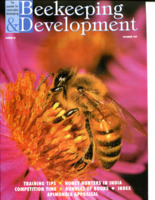 Honey Hunters of the Nilgiris - The Road to Sustainability_1997 December_Beekeeping & Development The document discusses the traditional practices of honey hunting among tribal communities in the Nilgiris Hills of Tamil Nadu, India, particularly focusing on the Kurumbas, Irulas, and Kathnaickens tribes. It highlights the cultural significance of honey hunting, which is intertwined with rituals, beliefs, and community cooperation, such as marking honey colonies and performing prayers before harvesting. The document also addresses the ecological and economic challenges these communities face due to changes in their environment and market dynamics, emphasizing the need for documentation and support to sustain their traditional livelihoods. Through a survey conducted by the NGO Keystone, the text aims to raise awareness about the importance of preserving these practices and the knowledge associated with them. Traditional methods/ways/techniques of honey hunting, material/Tools used for hunting, seasons of hunting, rituals/prayers follwed by the hunters before/after hunting.Beliefs/superstitions/traditioin of the hoeny hunterscommunities.
Honey Hunters of the Nilgiris - The Road to Sustainability_1997 December_Beekeeping & Development The document discusses the traditional practices of honey hunting among tribal communities in the Nilgiris Hills of Tamil Nadu, India, particularly focusing on the Kurumbas, Irulas, and Kathnaickens tribes. It highlights the cultural significance of honey hunting, which is intertwined with rituals, beliefs, and community cooperation, such as marking honey colonies and performing prayers before harvesting. The document also addresses the ecological and economic challenges these communities face due to changes in their environment and market dynamics, emphasizing the need for documentation and support to sustain their traditional livelihoods. Through a survey conducted by the NGO Keystone, the text aims to raise awareness about the importance of preserving these practices and the knowledge associated with them. Traditional methods/ways/techniques of honey hunting, material/Tools used for hunting, seasons of hunting, rituals/prayers follwed by the hunters before/after hunting.Beliefs/superstitions/traditioin of the hoeny hunterscommunities. -
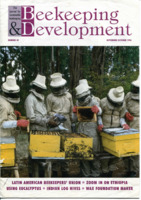 Log hives of Sorag_1996 September- October _Beekeeping & Development The document discusses sustainable beekeeping practices in a village in the Pindar Valley, Uttar Pradesh, India, where local farmers use log hives made from hollowed-out logs of native trees to keep Indian hive bees (Apis cerana). These log hives, which are cost-effective and constructed from local materials, provide excellent insulation against cold temperatures, allowing large bee colonies to thrive during harsh winters. Honey is harvested twice a year, primarily for personal use rather than sale, while wax is typically discarded. The article emphasizes the advantages of this traditional beekeeping method, including the ease of passing down knowledge through generations and the hives' resemblance to natural nesting sites, highlighting a sustainable approach to beekeeping that aligns with local environmental conditions.
Log hives of Sorag_1996 September- October _Beekeeping & Development The document discusses sustainable beekeeping practices in a village in the Pindar Valley, Uttar Pradesh, India, where local farmers use log hives made from hollowed-out logs of native trees to keep Indian hive bees (Apis cerana). These log hives, which are cost-effective and constructed from local materials, provide excellent insulation against cold temperatures, allowing large bee colonies to thrive during harsh winters. Honey is harvested twice a year, primarily for personal use rather than sale, while wax is typically discarded. The article emphasizes the advantages of this traditional beekeeping method, including the ease of passing down knowledge through generations and the hives' resemblance to natural nesting sites, highlighting a sustainable approach to beekeeping that aligns with local environmental conditions. -
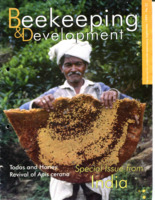 Beekeeping and Development - The Journal for Sustainable Beekeeping - Special Issue from India - September 1999, No. 52 This special issue of the journal contains contributions from researchers working and associated with Keystone. 1) Pratim Roy: Bee-diversity across a Tropical Tract - Honeybees and People in India - An Overview 2) Mathew John: Marketing of Honey and Bees Wax 3) Robert Leo: Trees Bees Use - My Favourite Bitter Honey 4) Keystone Foundation: Revival of Apis Cerana in South India
Beekeeping and Development - The Journal for Sustainable Beekeeping - Special Issue from India - September 1999, No. 52 This special issue of the journal contains contributions from researchers working and associated with Keystone. 1) Pratim Roy: Bee-diversity across a Tropical Tract - Honeybees and People in India - An Overview 2) Mathew John: Marketing of Honey and Bees Wax 3) Robert Leo: Trees Bees Use - My Favourite Bitter Honey 4) Keystone Foundation: Revival of Apis Cerana in South India -
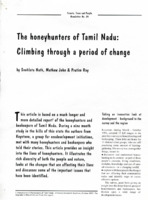 The Honeyhunters of Tamil Nadu: Climbing Through a Period of Change Based on the report 'Honeyhunters and Beekeepers of Tamil Nadu - A Survey Document, Keystone, October 1994'. The provides an insight into the lives of honeyhunters and beekeepers.
The Honeyhunters of Tamil Nadu: Climbing Through a Period of Change Based on the report 'Honeyhunters and Beekeepers of Tamil Nadu - A Survey Document, Keystone, October 1994'. The provides an insight into the lives of honeyhunters and beekeepers. -
 Honey Hunters of the Blue Mountains Honey hunting practices of Kurumba community in Nilgiris, started off with work in Semmanarai,. Work of other areas in Coonoor were also featured.
Honey Hunters of the Blue Mountains Honey hunting practices of Kurumba community in Nilgiris, started off with work in Semmanarai,. Work of other areas in Coonoor were also featured. -
 Honey Hunters and Beekeepers of Tamil Nadu The document presents a survey on honey hunters and beekeepers in Tamil Nadu, highlighting the significance of these activities in rural development and the sustainable use of natural resources. It discusses the traditional practices of various tribal groups engaged in honey hunting and beekeeping, emphasizing their cultural connections and the challenges they face due to modernization, land use changes, and economic pressures. The document details the ecological and socio-economic implications of these practices, noting the importance of indigenous bees and the impact of external factors on the livelihoods of these communities. It also addresses the need for appropriate technology and management strategies to support tribal beekeepers while preserving their cultural heritage and ecological balance. Primary survey of TN Honey hunters. 16 tribal communities and surveyed 11 hill areas To see the status of beekeeping and honey hunting skills and issues related to bees and the environment
Honey Hunters and Beekeepers of Tamil Nadu The document presents a survey on honey hunters and beekeepers in Tamil Nadu, highlighting the significance of these activities in rural development and the sustainable use of natural resources. It discusses the traditional practices of various tribal groups engaged in honey hunting and beekeeping, emphasizing their cultural connections and the challenges they face due to modernization, land use changes, and economic pressures. The document details the ecological and socio-economic implications of these practices, noting the importance of indigenous bees and the impact of external factors on the livelihoods of these communities. It also addresses the need for appropriate technology and management strategies to support tribal beekeepers while preserving their cultural heritage and ecological balance. Primary survey of TN Honey hunters. 16 tribal communities and surveyed 11 hill areas To see the status of beekeeping and honey hunting skills and issues related to bees and the environment -
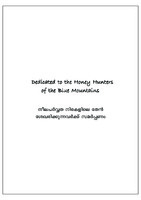 Handbook on Honey Hunting and Beekeeping The document explores the traditional practice of honey hunting among indigenous communities in the Nilgiri region of India, highlighting the ecological and cultural significance of this activity. It describes the rich biodiversity of the area, particularly the habitats of the Giant Rock Bees, which are crucial for honey production. The document contrasts different honey hunting techniques, such as tree and cliff hunting, and emphasizes the socio-cultural rituals and beliefs surrounding the practice, including the respect for bees and the environment. It also discusses the economic aspects of honey harvesting, the tools used, and the importance of sustainable practices to ensure the survival of both the bees and the traditional knowledge of the honey hunters. Overall, it illustrates how honey hunting is intertwined with the identity and livelihoods of the local communities while promoting conservation and respect for nature.
Handbook on Honey Hunting and Beekeeping The document explores the traditional practice of honey hunting among indigenous communities in the Nilgiri region of India, highlighting the ecological and cultural significance of this activity. It describes the rich biodiversity of the area, particularly the habitats of the Giant Rock Bees, which are crucial for honey production. The document contrasts different honey hunting techniques, such as tree and cliff hunting, and emphasizes the socio-cultural rituals and beliefs surrounding the practice, including the respect for bees and the environment. It also discusses the economic aspects of honey harvesting, the tools used, and the importance of sustainable practices to ensure the survival of both the bees and the traditional knowledge of the honey hunters. Overall, it illustrates how honey hunting is intertwined with the identity and livelihoods of the local communities while promoting conservation and respect for nature. -
 Bear-proof stand for Beehive
Bear-proof stand for Beehive
